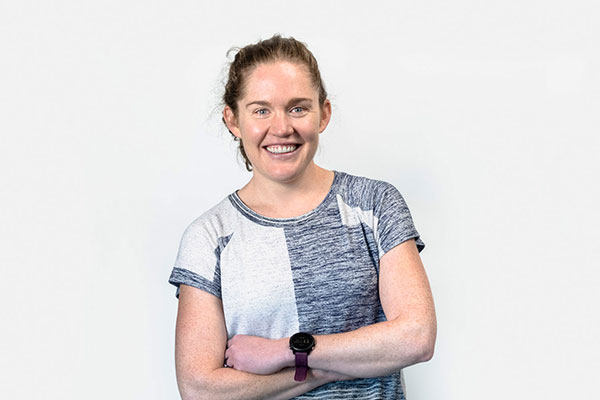DOES THE FIT OF FOOTWEAR MATTER FOR PERFORMANCE?
By  Dan Feeney
Dan Feeney  Kate harrison
Kate harrison
Follow on ![]() @Dfeeney31 and @running_geek
@Dfeeney31 and @running_geek

The perfect fit of a shoe is hard to describe, but we all know it when we feel it. Often overshadowed by the latest and greatest midsole foam or outsole rubber, fit is critical to performance. We are focused on fit; quantitatively measuring its impact on human performance and sharing our findings with a wider audience.
Quick takes
- Multiple studies show that optimally fitting footwear significantly impacts performance through altering athlete biomechanics.
- All shoes/boots begin with a universal last and rely on a fit or closure system to conform to individual foot shapes.
- Feet change shape during movement, and footwear should accommodate these changes to optimize performance (think of this as dynamic fit).

Dan’s take:
I am passionate about scientifically answering this question; of course, fit matters, but how much? This has been my opinion for a long time and not just because it is my job to investigate the relation between fit and performance. During the day, I work as a Biomechanics Research Engineer at BOA, but the rest of the time you can find me trying to run fast from the track to the trails. I have a Ph.D. in neurophysiology and am a connoisseur of all things that help improve performance: from biomechanics to training and nutrition. I also raced at the Division 1 level in cross country/track and professionally in triathlon, so these topics are really engrained into everything I do!
While midsoles and outsoles have rapidly changed over the past few decades with no small amount of research on them, most shoes still are closed with a simple lace down the middle of the foot, and this is where we believe the next great opportunity lies.
While it is hard for many to describe what perfect fit feels like, we all know good fit when we feel it. While you occasionally read about exceptions like the Tarahumara who run in sandals, these are the exceptions, not the rule. Personally, I am not about to trade in my sneakers for flip flops any time soon!

Kate's Take:
As athletes, we can become obsessed with numbers. I grew up playing all the sports – hockey, soccer, snowboarding, golf – you name it. I get it; a fraction of an inch can mean you scored, or the puck dinged off the post. A few degrees off on your landing means you eat in on the slopes. While I enjoyed all sports, I eventually found my sweet spot in running and ran collegiately at West Virginia University, and as a member of Canada’s National Cross Country team. I’ve been on both sides of the fine line between earning All-American honors, or national team berths, and being an also-ran. Usually, the separation is measured on the order of seconds or inches.
Since I can’t spend my entire day training, I’ve filled the rest of my time learning about how to optimize performance to shave off those almighty seconds. I’ve earned degrees in Exercise Physiology, and my PhD in Movement Science. Now I get to study sport performance as a researcher at BOA Technology. As both an athlete and scientist, I have a particular appreciation for data. In fact, I, and I’m sure many (most?) other athletes, can fall into to the trap of disregarding what we can’t measure. A quality as ethereal as shoe fit can fall by the wayside. And yet, when taken to the extreme, let’s say an angry blister or a jammed toe, its apparent that how our foot interacts with our shoes can have a real influence on how we move, and thus how we perform. The challenge lies in quantifying and then improving upon the ways in which shoe fit affects our movement, so we can seek every bit of performance out of our efforts on the field.

BOA’s Take:
Since we are writing this on the clock, we should mention how we test Fit in our lab at BOA. Within our Performance Fit Lab, we test how Fit impacts performance in three areas: Agility & Speed, Endurance & Health, and Power & Precision. Most sports require a balance of these three benefits. Finding the equilibrium in the three benefits for a specific product is where the fun begins.
While the biomechanics of Fit is in its infancy, there is a growing area of scientific literature addressing exactly what optimal Fit looks like across activities and we are using biomechanics to improve the fit and performance of products.
Research on the topic
Our anecdotal experience as athletes (and our careers researching the biomechanics of fit) lead us to constantly ruminate over the question, Does fit matter? And if so, why? And how? Believe it or not, we aren’t the only scientists to consider these questions. Legendary footwear researcher Benno Nigg noticed over the course of his career – and its been a long one - that despite decades of research, the evolution of running shoes had failed to make a meaningful impact on performance and injury. In fact, runners are getting injured as much now as ever. In 2015, he offered a new approach – every runner is unique, and has their own “preferred movement path”. This preferred movement path would allow them to run with the least strain on their personal body structure and physiology, and thus reduce risk of injury and run more efficiently. He suggests that athletes should select shoes that they perceive to fit them well to run longer with less physical injuries.
Any athlete will tell you, being healthy is the first step to performance. If you want proof, just look at the numbers. Anywhere from 20-80% of runners are injured every year, preventing them from even starting the race. One factor suspected to contribute to injury is vertical loading rate – a measure of the impact of the ground on a runner’s body with each step. It turns out that how your shoe fits and feels can play an important role in how you hard you land. This can be seen in differences as seemingly inconsequential as how you lace your shoes. Have you ever noticed that lonely hole at the top of the eyerow on your shoes, right at your ankle, and wondered why it was there? Maybe you have, and even know about the “runners loop” technique, but thought it was too much of a pain to make that extra crossing every day. Turns out, it may be worth the time. A 2009 study (Hagen and Hennig, 2009) evaluated this technique, and found a significant reduction in loading rate in the “runners loop” condition – using 7 eyelets - compared to how runners typically lace their shoe – using 6 eyelets. I (Kate) personally prefer BOA-powered footwear, but when I have to wear laces, I make the best of them by using all the eyelets!

The Saucony Switchback 2 designed and tested in our lab for Agility & Speed and Endurance & Health. This is one trail shoe I (Dan) am personally stoked for: the first version fit well, but we significantly improved fit and Saucony upped the ante with improved foam and underfoot protection in the second version.
How we use biomechanics to help in product design
In the Performance Fit Lab at BOA, we test products that are heading to market to make sure they live up to benchmark improvements we see from large-scale studies. In the future, we will dive into our testing process and how it aligns with how shoes are made. For now, here are a few of the products that we have put through the paces in our lab, providing data on the performance improvements enabled by our Performance Fit System.

The Adidas Stycon BOA includes a tri-panel structure under the shroud. This was one of the first shoes to come through our lab where we explicitly tested and saw how fit could improve performance on the court.
What about retail?
Fit is the primary reason behind why a consumer returns their footwear, and biomechanical testing of products can reduce these mismatches and improve performance. We, like many of you, have bought running shoes based on a technology that should improve our running performance, only to realize we could not get the shoe to fit well. Take the Nike Vaporfly 4% flyknit: I was beyond excited to buy a pair after seeing all of the hype and even being a test subject (Dan) in the seminal 4% study. Unfortunately, the version of the shoe that made it to production just could not get fit in the right areas and often left my forefoot with blisters.
I (Kate) was excited at the advent of the knit upper in athletic shoes – who doesn’t love a shoe that feels like a sock when you slip it on? But when I started rolling off the side of my shoes taking switchbacks on the trail, I realized the upper fit was about more than just step in feel. The fit of a shoe has to be dynamic, and hold you when the going gets tough. Getting proficient on trails is still a work in progress for me – I can’t afford to be losing any agility! While we can salvage a poorly fitting shoe on easy and short runs, the fit has to be dialed in for a long day on the mountains or a marathon at full tilt.

What does this mean for the athlete?
It's time to start thinking about fit being as crucial as midsole foam, carbon plates, grippy outsoles, etc. The best technology in the rest of the shoe is only effective if it conforms to your foot shape. Research clearly demonstrates the importance of fit for athlete performance, but footwear innovation often focuses on other attributes of the shoe. By obtaining a superior fit, you could be reducing injury risk, cutting faster, or riding with less stress on your feet (see the research section above). Nobody wants to second guess their movements down a steep slope, in a tricky rock garden, or in the middle of a match.
Concluding remarks
In essence, fit truly matters to performance. Each month, we’ll share new findings and ideas in this pursuit, and are looking forward to hearing what you think! Future topics will be more focused on single areas, so please reach out if you have any ideas or topics you would like us to cover.
We can be found on Twitter @Dfeeney31 and @running_geek.